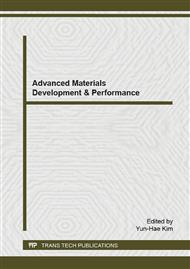p.13
p.19
p.23
p.27
p.32
p.36
p.40
p.44
p.51
Estimation of Mechanical Behavior for Particulate Reinforced Composites at Different Temperatures
Abstract:
Particulate reinforced composites show viscoelastic behavior under various loading conditions. It is important to estimate mechanical behavior when this material is used for solid fuel on rocket motor. Cracks can be generated and propagated due to high combustion pressure in the service time. These cracks expand the burning area and lead to excessive combustion. Consequently, the rocket motor can cause malfunction or the performance deteriorated. In this study, edge cracked sheet specimen was used to perform the crack propagation tests. These tests were conducted in the range of temperature from -60°C to 60°C under 2.54 and 12.7 mm/min of strain rates. Based on the results, the stress intensity factors and the crack propagation rests were calculated. The crack resistance curves show the transition that stress intensity factors increases as temperature decrease. Also, fracture surfaces were investigated by scanning electron microscope to determine the fracture behavior under various temperatures.
Info:
Periodical:
Pages:
32-35
Citation:
Online since:
June 2015
Authors:
Price:
Сopyright:
© 2015 Trans Tech Publications Ltd. All Rights Reserved
Share:
Citation:


